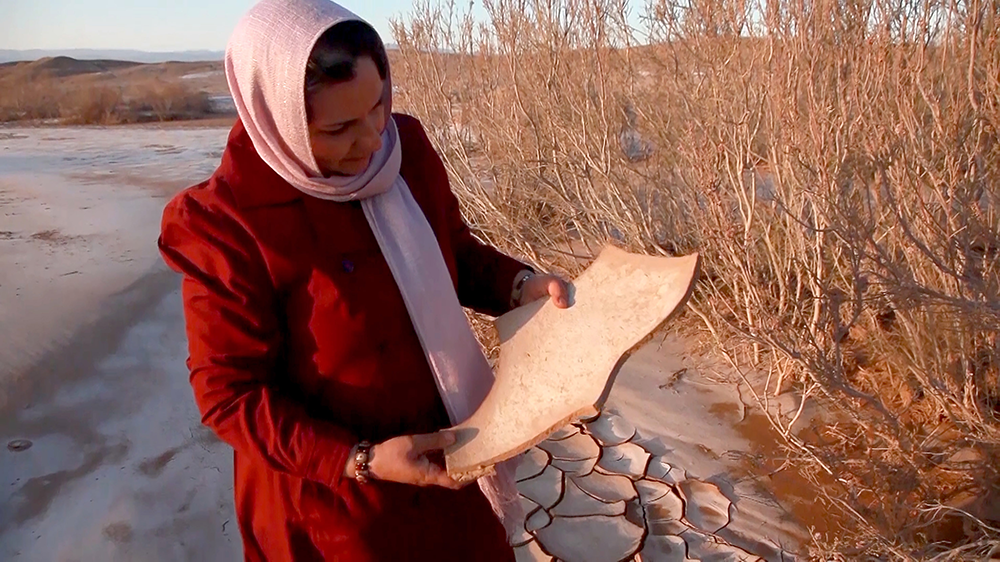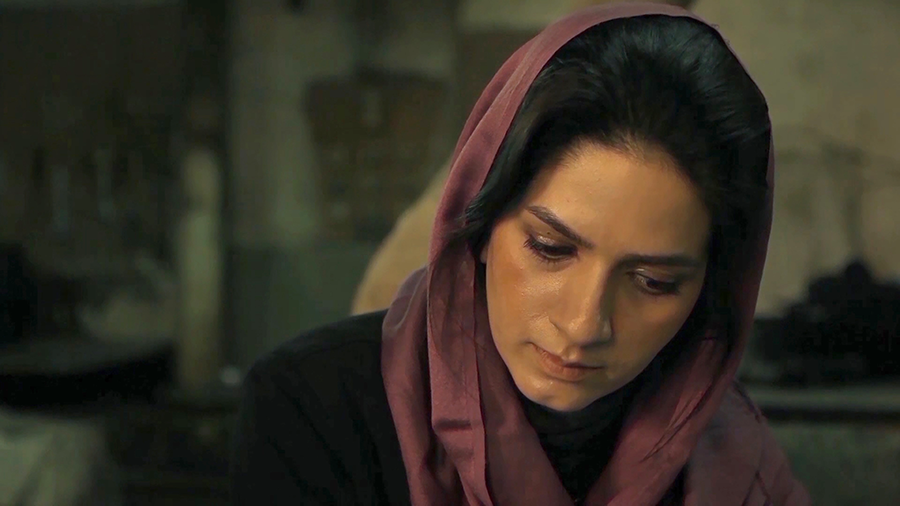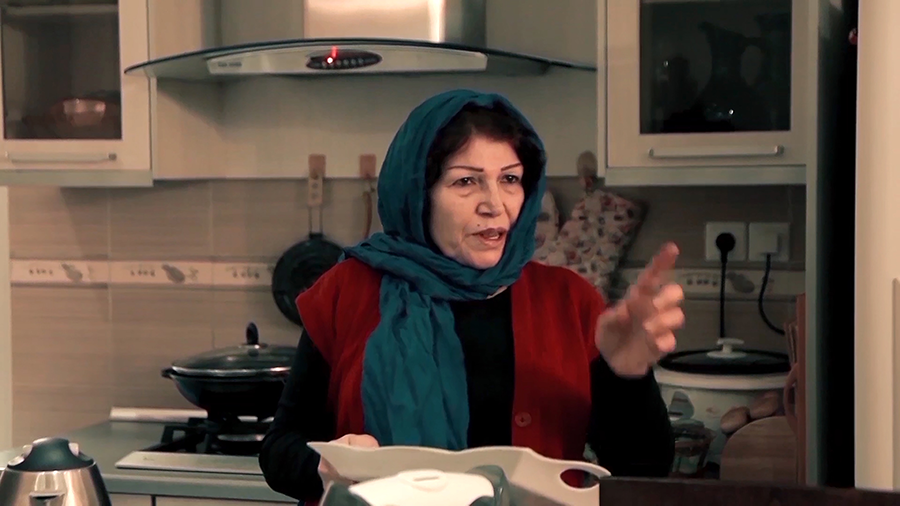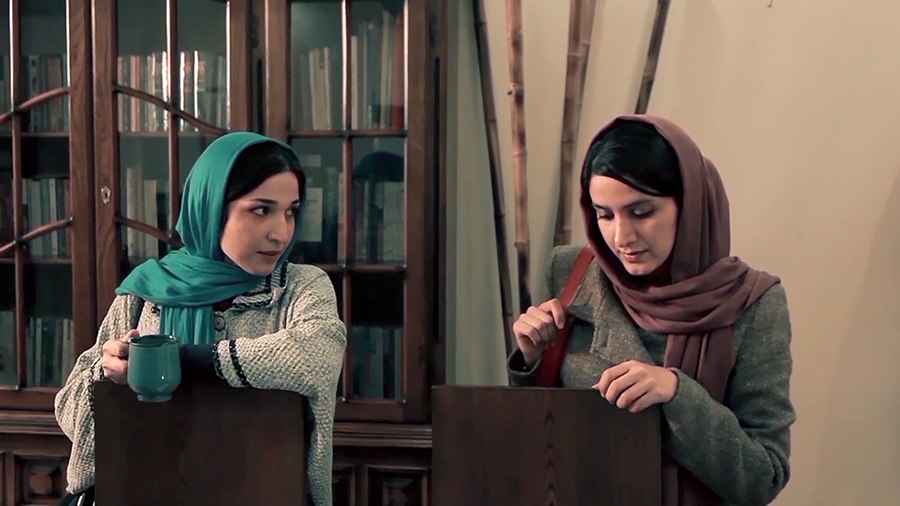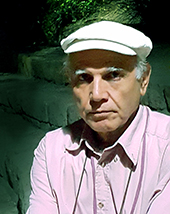
Interview with the film director
By Farnoush Aba
Why did you decide to make this film after so many years?
I made a film called “Emigration” three years ago, so this film, I mean “who are we?”, was made after three years. Any way every film or art work is the result of a mental exploration which is formed and created in the mind. The subject of this film is one of my mental concerns.
Please explain a little about this film and its subject and tell us how the idea of making this film came to your mind?
I think that one of the most important issues that we face nowadays is the identity crisis that is running inside us. Who are we? And after this, another question may come to our mind: “who could we be?” This is the question that Bahram, I mean the first character of the story, asks himself constantly. Who am I? And this can be everyone else’s question.
Bahram thinks that his life is wasted. I have met many young people who told me that their lives and their youth had been wasted for some reasons. I also think that, I have lost many opportunities because of the special conditions of our society. This is how the idea of the film is formed in my mind. The idea which had been on my mind for years and finally turned into a film.
The story of the film is about a man named Bahram who loses the opportunity to live with a girl because of her emigration. Then he finds out that those who raised him are not his true parents. These issues confuse his mind and lead to result in raising some questions which bother him. One of the questions is that, if his true parents had raised him, he would have been someone else.
Unlike Bahram who does not accept his current life and considers his life a wasted life, his friend whose name is Reza and is a craftsman copes with his life, whatever outcome it has for him. All the time Bahram is thinking about that if society had gave him the opportunity, he would been lived as someone else, flourished his talents and showed his abilities. But an incident deprives him from this Possibility. He tells the bird he has brought home to be his companion:
Every man is given the opportunity to live only once and my only opportunity has been wasted. Bahram is the representation of this awareness. This awareness puts Bahram in to the threshold of despair and absurdity. Bahram is the representation of “these losses”. Bahram is the symbol of those who say that their lives have been wasted because of the bad conditions. Bahram knows that if the society is in order, life provides many opportunities for people to flourish their talents.
Although Bahram, the main character of the story, is a craftsman, but he is also interested in poetry and literature. Reza is just a craftsman. Explain a little about the friendship of these two main characters of the story, whose only common feature is industry, and tell us why Bahram doesn’t have a friend like himself?
Reza was found while the script was being written and he stayed and didn’t leave. Maybe because his character is different from Bahram’s and so Bahram’s personal characteristics can be Seen better beside him. Not only the personality of Reza but also the character of Bahram’s wife is different from Bahram’s. Bahram says after the Islamic revolution and after the emigration of his beloved girl, he didn’t care to whom he marry, with whom he lives and with whom he becomes friend.
So he probably entered to the industry field without any interest and love. Bahram became disappointed and gave up everything when he realized the unorganization, disorder and anarchy of his life.
In this situation it is the others who choose him and he does not choose them. He has lost his power and right to choose. It can be said that it was Reza who became friend with Bahram. When someone becomes mentally disabled due to many problems, it is others who make decisions for him/her.
Bahram and Reza are the symbol and representation of what society stratification or categorization?
Bahram is the symbol of wasted desires or regret of an ideal and desired life which is wasted. Bahram is the result of social determinant. The determinant which is not obvious and is not seen but exists and determines his fate. Bahram knows this. Someone who is born in house number 11 will have a different fate from someone else who is born in the next door house number 12. And neither of these two, have chosen their own fate, but they have been born inside it and inevitably follow it or better to say they are leaded to its end. This example is also applicable for the people of two different countries. Their fate depend on the country in which they were born without any choice.
Bahram perceives and understands this matter consciously and he knows that one of these two persons in these two places may have a bad fate, without having chosen it. It is very painful and grievous for him. He knows that he has not have a right to choose from the beginning of his life.
On the contrary Reza is somewhat pleased and satisfied with everything. Because his mentality, his morality and the conditions of his life is very different from Bahram’s. This question that he could be another person may not even comes to his mind and even if it comes to his mind, it will not bother him so much and will not attempt to change it.
He accepts his life as it is and as is destined for him. So for all these reasons, he is free from mental concerns and stresses. Although his business is not running well, when he finds out Bahram is sad, tells him: Come on, Black will take no other hue and it can’t get worse. And it means that he also accepts worse conditions. When Bahram shows him the letter of his true parents, at first he is shocked a little, but then says: what difference dose it make whose child you are. When Bahram wants to go to shiraz and finds out who were his true parents, Reza tries to prevent him from going, and says: Maybe they are dead or maybe they were addicted to drugs.
This does not matter much to him or he thinks that what’s done is done and Bahram has to get along with it and accept it. Reza is the symbol of people who ask no question. The ultimate thing he wants is to know, not to understand. Reza is looking for the subject of the story, but Bahram is looking for the reason and argument of the story.
Bahram and his wife have marital problems. Because they are far apart emotionally. For this reason after his mother’s death, Bahram goes to her house to live alone. And its another wrong choice.
Their world is completely different. Maybe the reason is that they got married and entered to each other’s lives by accident. Bahram goes to his mother’s house to escape from his chaotic and disturbed life. From the conversation between Bahram and his wife in his mother’s house we finds out that Bahram has spent his free times reading books. But his wife doesn’t accept it and considers him a hallucinate, and she wonders why he has left her companion and choose the books to associate.
Bahram says books are the only joy in his life and he wishes everyone was in the hallucination of books. None of the characters in this film are to blame, because of their special natures and characters, and because they are in each other’s lives by accident.
They did not choose, rather they were be chosen. Bahram gets a chance and opportunity to choose after his mother death. And he chooses being alone. When his wife tells him: What about us? Bahram says there is no us, each of us is living for ourselves. And he is right.
It seems that Bahram chooses a bird as a companion to escape from this life which is not ideal and favorable for him.
That’s right. Spending time with birds and animals is to be a substitute to living with mankind. Because living with animals is more pleasant. Being with animals does not bother men. When Bahram sees the bird constantly goes from one side of the cage to the other, he identifies with that bird and says: You have beautiful feathers, but where you can fly to? I also was a rolling stone in my stupidity life and finally become this person you see.
Although now I get a little perception and knowledge but it’s not useful for me anymore. Confession to his stupidity is one of the characteristics personal features of Bahram.
Bahram’s daughter is not married and she intends to emigrate in future. It seems that the conditions are not appropriate and suitable for her either, but unlike her father, she has not married under these bad circumstances.
Due to the high costs and also unemployment in the society, there is not suitable and proper condition for an appropriate and ideal marriage for Bahram’s daughter, Bahram’s mother nurse and many other young people in the country. But Bahram is worried about his daughter possible emigration which will make him more lonely. Brahma’s daughter belongs to a different generation and she is aware of the differences between her parents, that’s why unlike her mother who wants Bahram to come back home, she is agree with that his father lives alone, so as she says he will get rid of their complaints and grumbles.
It’s true that Bahram lives with despair and a kind of Existentialism. But he does not accept what society determines for him. It means that he does not accept what is given to him, even if he can’t change it or choose another path for his life.
Bahram knows that, this is not what he deserves from life. He knows he deserves more. Although he can’t change the path of his life, but as you said he does not accept the current situation and unlike Reza, he wants to know, wants to find the reasons, and wants to understand. That’s why he asks a lot of questions. Someone who asks about things, will change the things. Bahram says in the psychology office: The most part of my life is wasted. Because I didn’t choose this path of life, rather I was laid to this path.
Nevertheless the psychologist tells him: It’s true that there is determinism but there is always a secondary road or a bypath to get rid of a situation. The psychologist who is his brother either says: The one who is in front of me has changed his path and now is in the bypath.
Bahram lives with despair and a kind of Existentialism. But he does not accept what society determines for him. It means that he does not accept what is given to him, even though if he can’t change it or choose another path for his life.
Bahram knows that it is not his share of life. He knows he deserves more. Although he can’t change the path of his life, but as you said he does not accept the current situation and unlike Reza, he wants to know, wants to find the reasons, and wants to understand. That’s why he asks. Someone who asks about things, will change the things. Bahram says in the psychology office: The most part of my life is wasted. Because I didn’t choose this path of life, rather I was laid on in this path.
Nevertheless the psychologist tells him: It’s true that there is determinism but there is always a secondary way to get rid of this situation. The psychologist who is his brother either says: The one who is in front of me has changed his path and is in the secondary way.
Bahram goes to his brother office enthusiastically, wistfully and longingly, but he does not say who is he and comes out of the office without saying his true name. that’s an impressive sequence.
He doesn’t go there to say who he is. He goes there to see a part of his identity and his wasted past. Actually his brother office is a representation of confrontation between what he is and what he could be. Not regarding Babak’s job which is a doctor, but it’s the representation of Bahram’s mental and emotional disorder and inquietude, compared to the inner peace of his brother Babak.
He goes there to reduce and relieve some of his nostalgic feeling to his true family. Introducing himself does not help Bahram, because it changes nothing for him. When Mehrbanoo shows Bahram the old photos of his family, tells him that if that incident had not happened, you would have been in these photos too. Not being in those photos is like a disaster for Bahram. Bahram goes to meet his brother to find out in what mood and mental and emotional state he would be if he either was in that photos. Actually Babak is the possibility of another being and another life which Bahram could have too.
It’s seems that Bagram’s intent to commit suicide is to get rid of this inner problem which is always with him and that is his wasted past and wasted life.
Bahram does not accept what is given to him, I mean his current identity, from the mother who has stolen him. Bahram tells Mehrbanoo: Mrs. Zahra had nothing to give me. She just raised me up. My life is wasted and passed in vanity and futility, and Bahram wants to eliminate this. But he meets a little girl by accident as if this little girl is a part of his new identity which has grown inside him, after he found his true parents. That’s why he changes his mind about committing suicide.
What is the most important feature of this film?
That Bahram doesn’t know whose child he is. Is he the child of tradition or modernity? Bahram who is the main character of the story is the symbol of identity crisis which all of us feel it. Speed of Technology development, and also the speed of various events and happenings in our modern world and their merging to our semi- traditional society are the reasons of our mental duality and behavioral disorganizations which can be called identity crisis and quandary. This state in Bahram’s or anybody else’s mind will be result in this question: who am I? , and evitable makes us seeking where we belong to, as Bahram does. Bahram is looking for his true identity.
We use the latest machines and drive the most modern cars, but our living conditions, I mean collection of our socio- cultural relations are not in a way that we have an appropriate, moderate and ordered behavior and treatment with that cars and machines, and it results in crisis, chaos and disorganization in outside and its reflection, I mean crisis, in inside of us. And Bahram is the representation of this crisis.
We know you as a painter- architect and also a sculptor before a director and filmmaker, In your opinion how these arts affect the motion picture, and are these arts also effective in your works?, and are the trace of these effects obvious and visible in your films?
Cinema or motion picture is picture and sound. It is moving pictures in terms of picture, and if we consider each frame or each plan as a painting, then its relation with painting art will be more clear and comprehensible. I mean all the rules and regulations about color, light and composition which are the basis of painting language, are also applicable in each frame of any picture in motion picture and actually motion picture is based on the same rules. Therefore a film director who is also a painter has this opportunity to make a film based on aesthetic rules of visual arts. In this case the director repeats and duplicates his/ her painting in thousands frames based on the rules of motion picture.
Habitually I consider motion picture as a moving painting. And therefore I arrange mise-en-scene composition in front of camera as a still life which I suppose to paint.
I use and profit the sculpturing aesthetic rules about volume in the movements, the way of standing and sitting of the actors and actresses. Environmental design is an important element in every motion picture’s mise- en-scene.
Having technical knowledge about architecture will result in a very good mise-en-scene arrangement. I have to say that all arts’ aesthetic, are connected and related to each other in warp and woof. If you find the clue and take it skillfully, then you can use and profit any branch of art in other fields of art, according to your power and capacity.
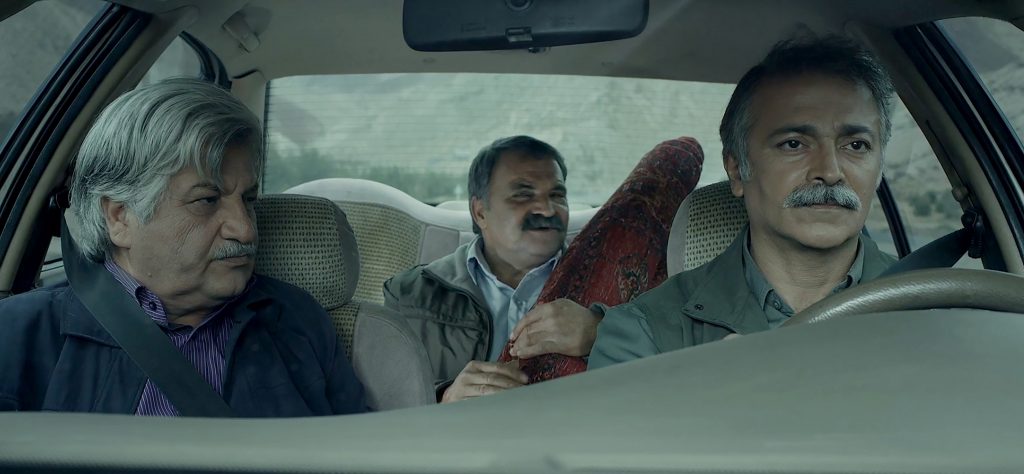
Review of Emigration film
Emigration
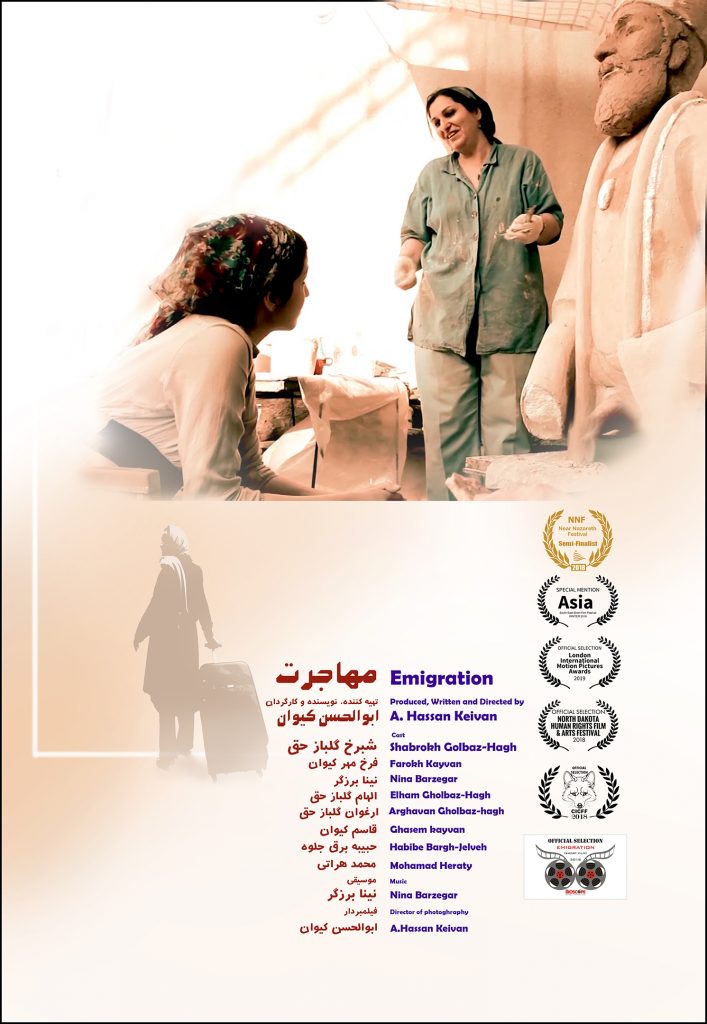
‘Emigration’ film is a struggle between moving or staying. A struggle of one to remain in her homeland with enough knowledge about the difficulties in the home country and moving to an unknown country with all its merits.
The central figure in the film is a woman who is in love with sculpturing but she doesn’t own a workshop and is compelled to work on the rooftop or a corner of a room. Despite such difficulties the sculptor is busy day and night creating her beloved sculptures. The woman is living in a country in which due to economic and social problems, her relatives have either migrated to other countries or are in the process of immigration or are thinking about the move or like the sculptor are undecided. Such an undecided situation bothers the artist and prevents her from focusing on her sculptures. Despite social difficulties and limitations, the woman prefers to remain in her homeland and build her beloved sculptures, but her husband and children have migrated abroad and she is compelled to follow them.
Breaking from an environment in which she speaks her mother’s tongue and has deep emotional attachment to it and enables her to create things to going to a country where everything is strange and new has alarmed her. She is worried lest her artistic instincts will dry up in the west because life means only creation for our lady. Thus we can see that upon receiving an order to fabricate a sculpture while she and her family are in the process of moving, love of creation compels her to stay and build a sculpture and suffer her family’s separation. This film in fact shows a struggle between moving and staying.
In various sequences in the film one can see the woman’s struggle to leave or stay among other characters that are in touch with her and face similar problem. Her college students are unhappy with their teacher’s decision to leave and although they want to move, they try to prevent her because they will lose a valuable instructor. The woman’s mother, who is 90 years old, also is reluctant to move out of her country and home, but she is compelled to leave because she has only one daughter, the sculptor, who has been left behind is taking care of her. Two Afghan citizens who are working in the casting section of the sculptor’s atelier also await their country to find peace so that they can move to their homeland. Love of returning to homeland can be detected in their sparkling eyes.
The images in the film are symbolic. The desert is the symbol of her motherland although it has nothing to show except thorns, but to our artist it is familiar and beautiful. The woman says (to her husband), “I live in this desert and belong to this desert.”
Cars and driving in the film is a symbol of moving and is shown almost everywhere. When the woman and her students are talking about emigration they are driving and when they are at the peak of frustration they drive into a dark tunnel..
The film ends with the woman driving to the airport. This short trip by taxi is also symbolic. The woman trip to the airport at night is another symbol representing the darkness and uncertainty surmounting the woman. In fact airport is a gateway to an alien and unknown country where her fate is unknown. Therefore, all the time that the sculptor is going to the airport by taxi she suffers inwardly and struggles between leaving and staying.
